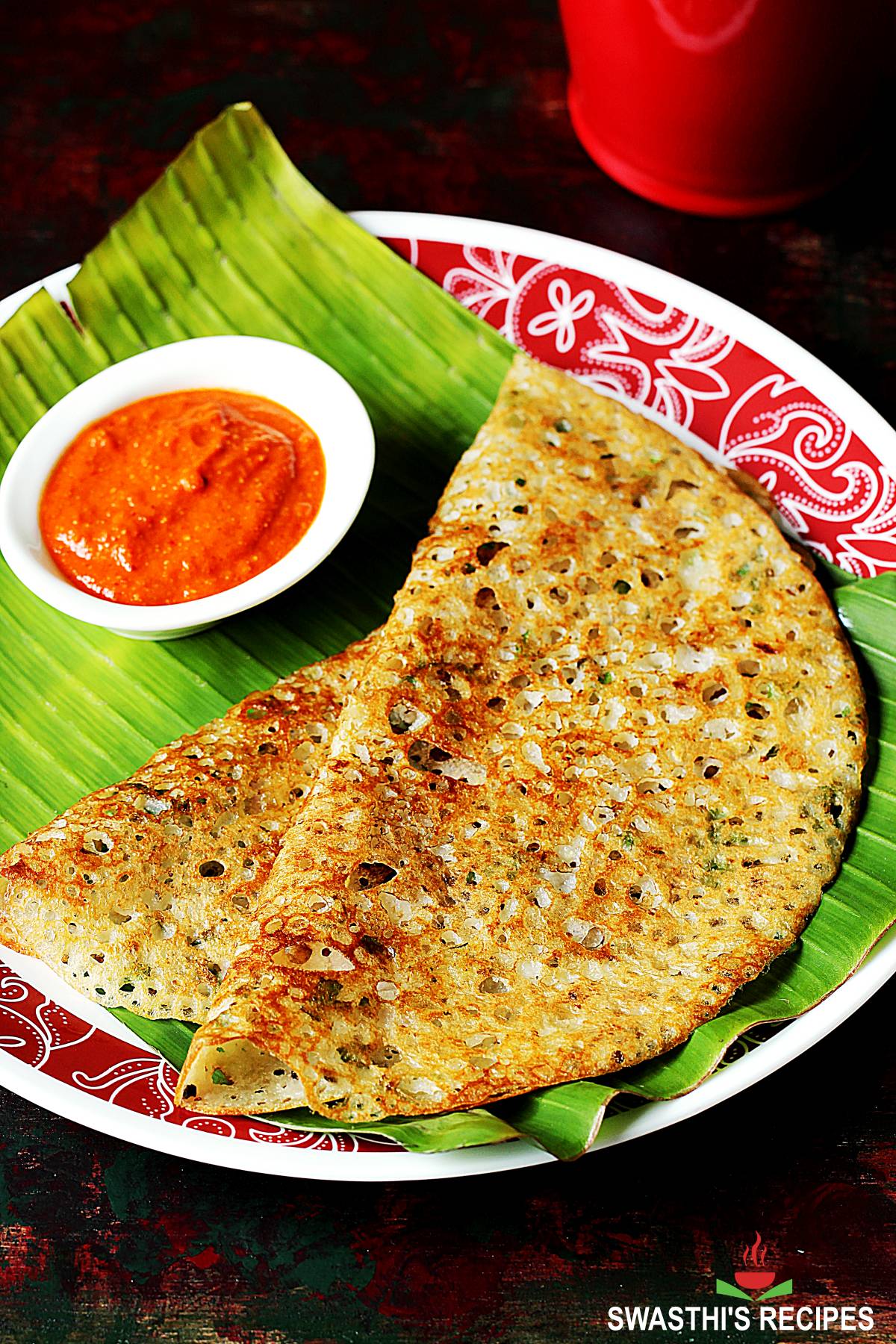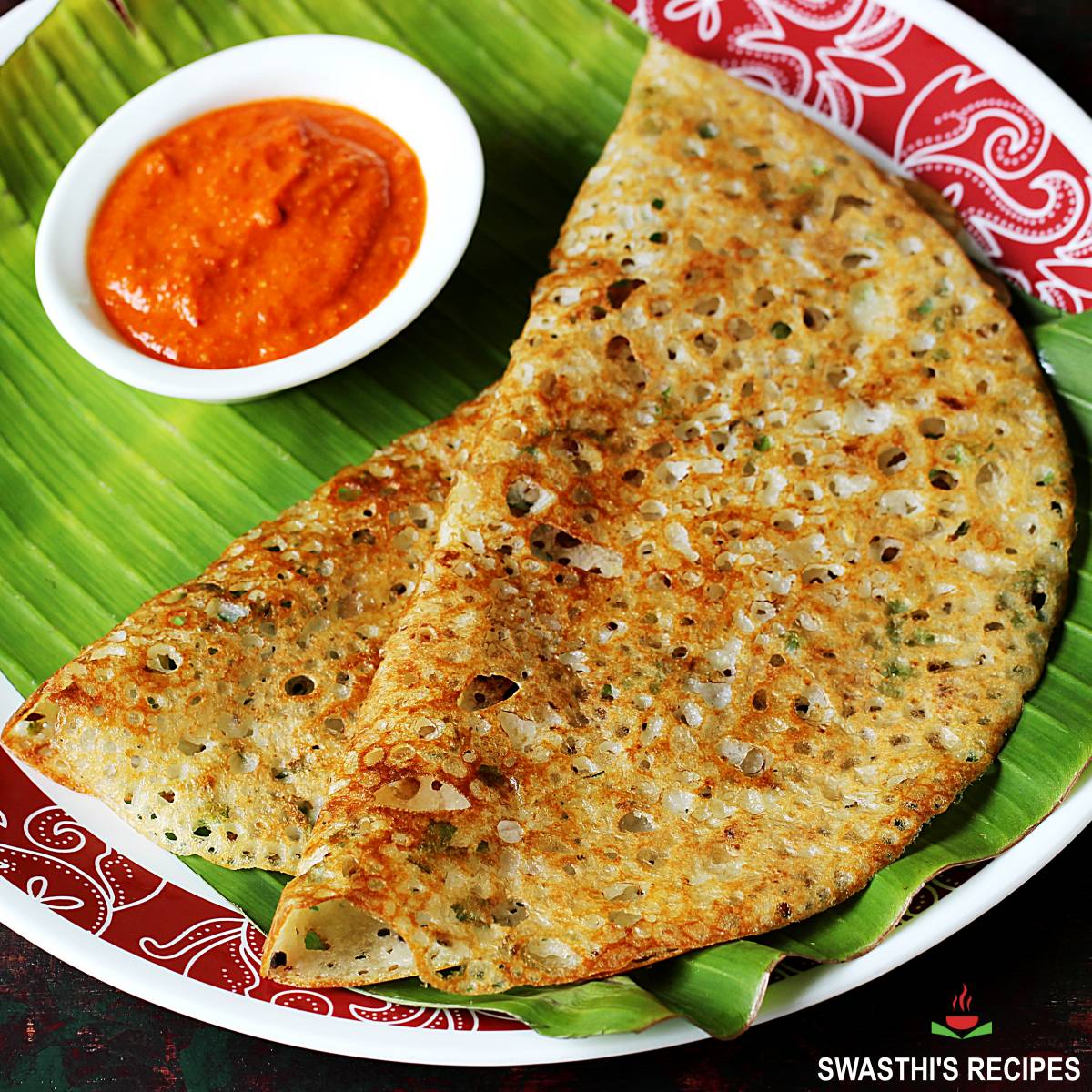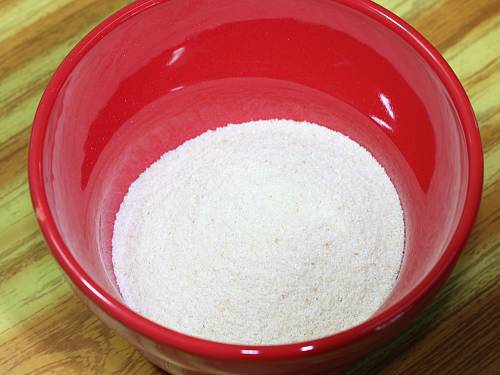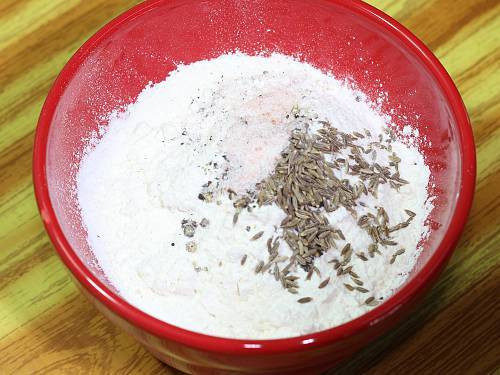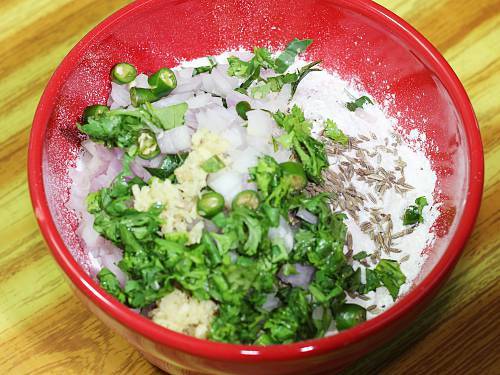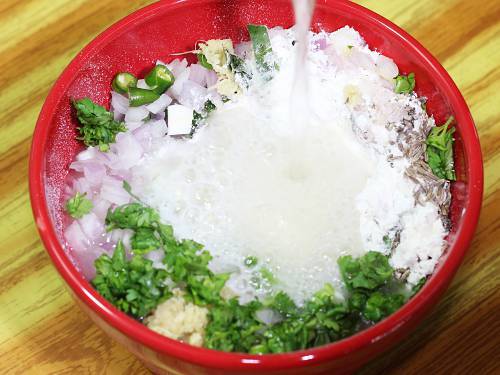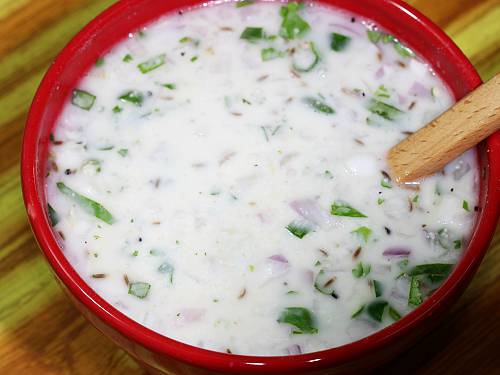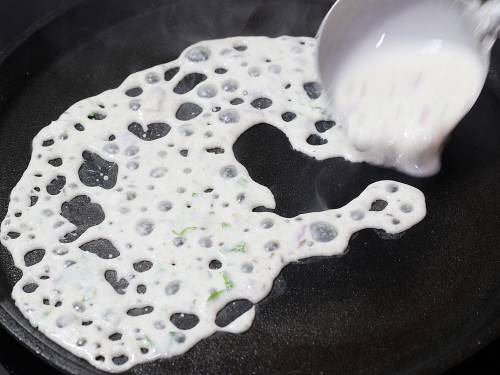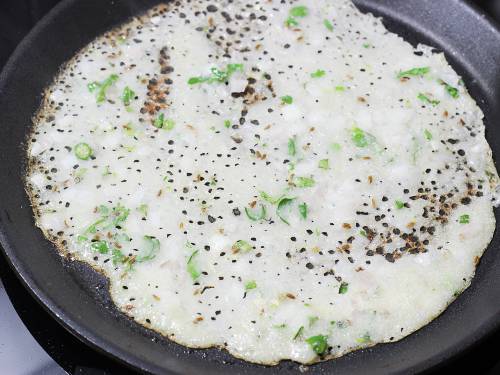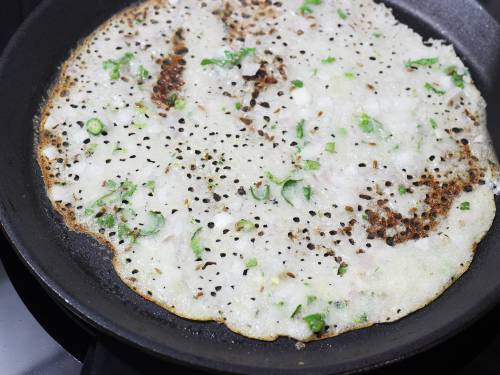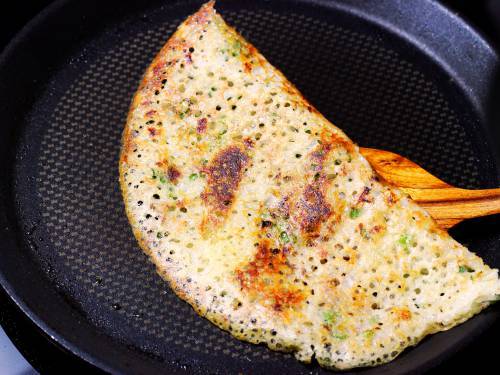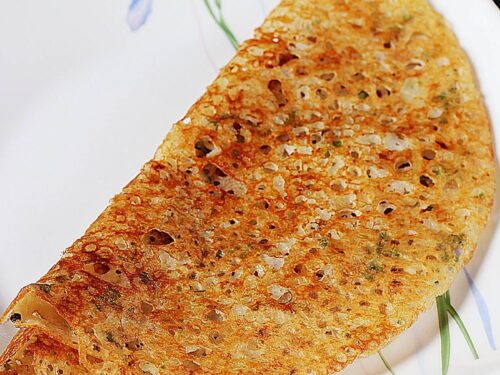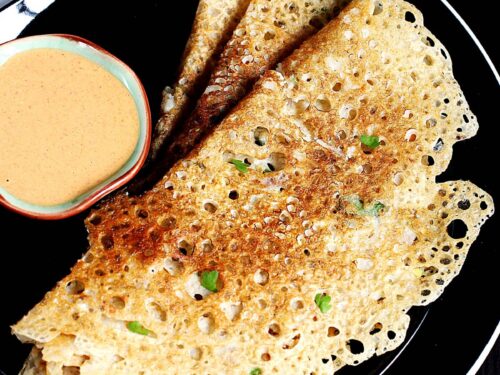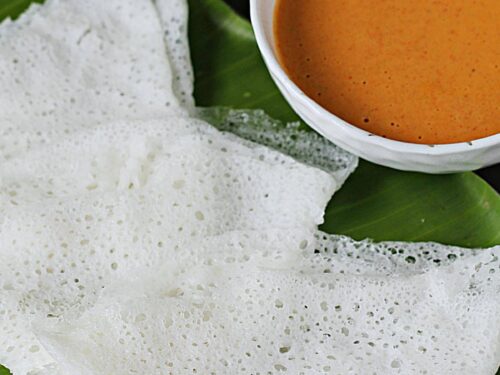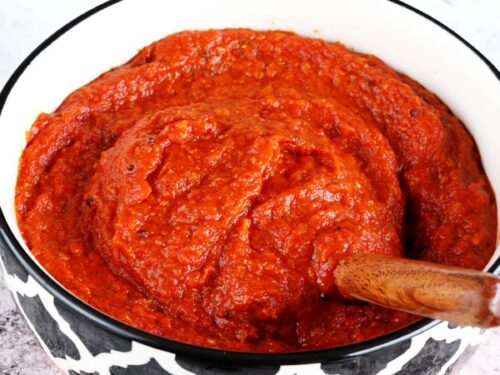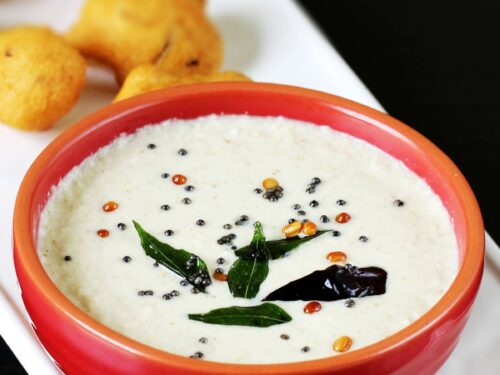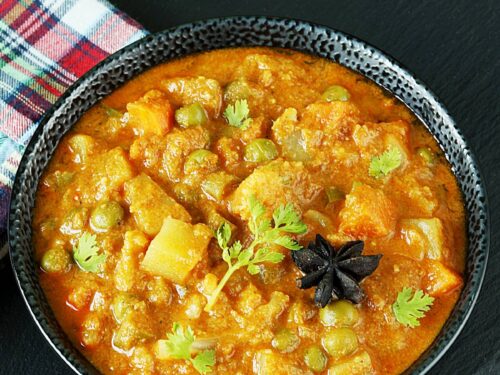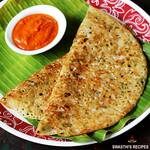If you are new to South Indian cuisine read on to know …
About Rava Dosa
Rava dosa also known as Suji Dosa, is a thin, lacy and crisp South Indian crepe made with semolina, rice flour, spices and herbs. ‘Rava’ is the South Indian word for ‘semolina’. ‘Dosa’ is a traditional thin ‘South Indian crepe’. So ‘rava dosa’ translates to ‘semolina crepes’. To flavor up the crepes, various spices & herbs like ginger, green chilies and cumin seeds are used. Rava dosa is an Instant dish where a thin batter is made with all the ingredients. It is then poured over a hot griddle to form a lacy crepe. A generous amount of oil or ghee is drizzled to cook them. The resulting crepes are golden, thin, aromatic and delicious. Traditionally dosas are made by soaking & blending rice and lentils to a batter. This is then fermented overnight & used. Making traditional dosas need a bit of planning, soaking and fermenting which is a 2 day process. These instant rava dosas are a great replacement to the traditional version since these can be made instantly without having to soak, blend & ferment the batter. For this reason these dosas are made often in the South Indian households. In Karnataka Tiffin centers, different kinds of rava dosas are made. Plain, rava masala, onion rava masala, dry fruits rava dosa are some of those. Rava masala dosa is one of the most popular and is made by stuffing potato masala similar to the masala dosa.
About This Recipe
This rava dosa recipe is pretty straight forward and is the same as it is made in every household and South Indian restaurants. This is a recipe which cannot be altered, meaning the proportions of rava, rice flour and all-purpose flour are always the same. Any changes to this is more likely to break the dosas. Using ingredients like onions, ginger, chilies, cumin and yogurt is up to you since these are added for flavor. More Breakfast RecipesBhatura recipeupma recipeSabudana khichdipoha recipe
How to Make Rava Dosa (Stepwise Photos)
Make batter
- Add ½ cup fine rava (semolina) to a large mixing bowl. I have used non roasted rava.
- To the same bowl, add ½ cup rice flour¼ cup all-purpose flour (maida)½ teaspoon salt½ teaspoon cumin seeds (jeera)¼ to ½ teaspoon crushed black pepper
- Next add 2 to 3 tablespoons onions (very fine chopped)1 green chili chopped (skip for kids)6 curry leaves finely chopped2 tablespoons coriander leaves (finely chopped)1 teaspoon grated ginger
- Add 1 tbsp curd (optional). This gives a golden color to your rava dosas but can be skipped. Pour 2½ cups water to make a runny batter.
- Mix everything well and make a lump-free batter. It has to be very runny and watery. Taste it and add more salt if needed. Cover and rest this for 20 mins.
Make Rava Dosa on Hot Tawa
- Heat a non-stick or cast iron pan on a medium high heat. When the pan turns hot, drizzle few drops of oil & grease it well with a sliced onion or a kitchen tissue or cloth. Wipe off the excess oil. Adjust the consistency: After resting batter does turn slightly thicker, so at this stage recheck the consistency of the batter by stirring it. If needed add more water and mix. It has to be more like watery. I added about 2 to 3 tbsps more at this stage.
- Stir the batter very well every time before you pour it to make a rava dosa. Ensure the pan is very hot and then pour the batter beginning from the edges across the pan. Next fill up the gaps in between. Do not pour the batter in one place. If your batter is very very thin you will get paper thin dosas with large holes. Once done with pouring the batter, reduce the flame to low.
- This was another time I made moderately thin rava dosas and not very very thin. This is how I make most of the times. Turn down the flame to low. Pour 1 tsp ghee or oil around the edges & on top.
- Let the rava dosa toast well on a low flame until the edges leave the pan. When done, the edges of the rava dosa will come off the pan easily. This is the time you know it is done. The batter will cook through well and shrink a bit.
- When you see all the batter is cooked fully, then fold and remove the rava dosa to a serving plate. Troubleshooting: Not all dosas need to be cooked on the other side. If your’s is browning at the bottom and still moist on top, then flip it and cook for 30 to 60 seconds. Lastly flip it back and toast until crisp. I did not toast mine on the other side. Before you make the next rava dosa, ensure the pan is hot enough. Then stir the batter well and then pour. The batter may thicken after a while. Just add more water and stir it as and when needed. Rava dosa is best served hot with a chutney. Serve them directly from the pan. They tend to turn softer when they cool down. Here are some sides you may want to tryCoconut chutneyVeg kurmaTomato chutneyPotato masalaTiffin sambar A well-made rava dosa will have a crisp, thin and porous texture. Here are some tips that may be helpful.
Pro Tips
- Use fine rava: Make sure you use only fine semolina also known as Bombay rava. Do not try this with other kinds of rava like whole wheat rava or bansi rava. The larger grains & bran in these kinds will prevent the dosas from roasting well and may break them.
- Consistency of batter has to be thin and of pourable. The consistency of the batter determines the texture of the rava dosa. Runny batter creates a porous texture here. You can make them anywhere from paper thin to moderately thin by adjusting the consistency of batter.
- Using the right kind of pan is crucial here. I make these dosas on a non-stick as well on a cast iron pan. If using a cast iron or an iron pan then it has to well-seasoned with oil. You can also use sliced onion to rub the pan before making every dosa. Do not try making these on a griddle that you use for toasting roti or naan.
- Flame & temperature: The pan has to be hot enough while you pour the batter. But cook on a low heat to get them crisp. Do not toast them on a high heat. The dosa will brown without turning crisp.
- Roasting : Remove the rava dosa when the edges begin to leave the pan. Do not forcibly pull it out from the pan. A well-cooked rava dosa leaves the edges from the pan on its own which is an indication that it is done.
- Pour the batter & not spread: To make traditional dosas, the batter is spread on the tawa. But here it has to be poured over the hot pan. Pour it all over the pan instead of spreading.
Seasoning tawa
- The key to make good rava dosas is a good tawa / griddle. If using a non-stick pan, then it can just be used straight away as it needs no seasoning. However many people use cast iron griddles to make their dosas. So sharing these tips for beginners:
- Heat your cast iron pan first. When it becomes very hot, reduce the flame to low and pour ¼ to ½ teaspoon oil. Spread the oil gently with a kitchen tissue or a cloth. Be careful as the pan is hot. Continue to heat on a medium flame until it begins to smoke. Turn off and cool down. Your pan is ready to make rava dosa.
- If your pan is new, then repeat this process 3 to 4 times until a thin glossy coating is visible on the pan. Every time you heat the pan with oil, a layer of fats will burn off on the pan and this creates a patina over it. So your pan will be absolutely non-sticky
Tricks
If you have a large family then these points may be helpful.
- Making a lot of these dosas isn’t easy as they take double the amount of time to cook than a regular dosa. So it is good to make them on 2 different pans (on 2 burners) at one time.
- Rava dosas are very light and are not filling if you eat them with a chutney. So it is good to pair them with a simple potato masala.
- Lastly If you make them very very thin or paper thin, then you may need to make a lot of them as they are not filling at all. Next I make them moderately thin and not paper thin. Plan accordingly when you make the batter.
Troubleshooting
- Dosa sticks to the pan: Grease the pan well. If needed rub it with a slice of onion before you pour the batter to make the dosa. Repeat this for every dosa.
- Rava dosa is thick: If the batter is not thin enough then you will get thicker and dense dosas. Add more water if it is thick.
- Dosa breaks if the batter is excessively runny. Add a few tsps of flour and rava proportionately. Related Recipes
Recipe Card
